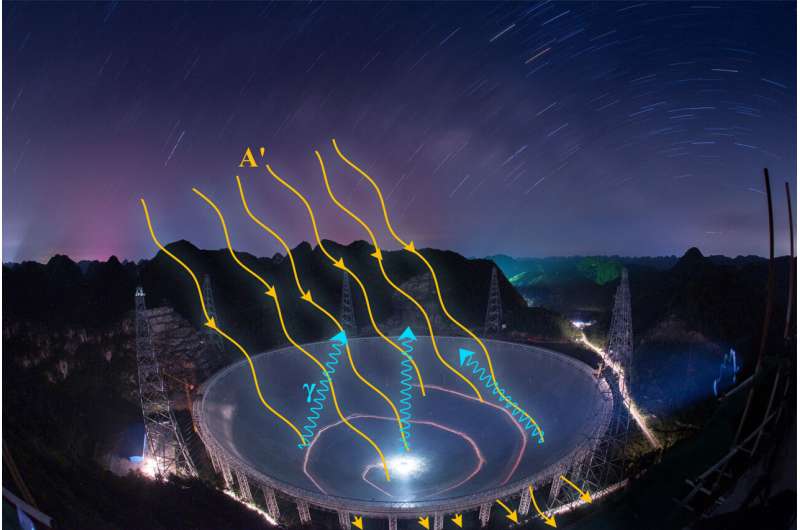The dark photon dark matter has a small probability converts into visible radio wave at the dish of Five-hundred-meter Aperture Spherical radio Telescope (FAST), but may be detected at the feed of the telescope. Credit: Xinhua.
Dark matter, matter in the universe that does not emit, absorb or reflect light, cannot be directly detected using conventional telescopes or other imaging technologies. Astrophysicists have thus been trying to identify alternative methods to detect dark matter for decades.
Researchers at Tsinghua University, the Purple Mountain Observatory and Peking University recently carried out a study exploring the possibility of directly detecting dark photons, prominent dark matter candidates, using radio telescopes. Their paper, published in Physical Review Letters, could inform future searches for dark photons, which are hypothetical particles that would carry a force in dark matter, similarly to how photons carry electromagnetism in normal matter.
"Our previous work studied the conversion of dark photons into photons in the solar corona," Haipeng An, one of the researchers who carried out the study, told Phys.org.
"This process involves the excitation of free electrons by dark photon fields, leading to the emission of normal photons. Building on this work, Jia and I considered using the free electrons in a dished telescope to induce electromagnetic signals and then using the FAST telescope to search for search such a signal."
Soon after, they started exploring the use of dished telescopes to search for dark photon-related electromagnetic signals, An and his colleagues realized that due to the non-relativistic nature of dark matter, the reflector in such telescopes would need to be spherical and the receiver of the signal should be placed at the center of this sphere.
Existing dished radio telescopes, however, such as the five-hundred-meter aperture spherical radio telescope (FAST) in China, are designed to observed remote radio signals, thus the shape of their dish is parabolic, with the receiver placed at the point of focus.
This meant that electromagnetic signals induced by dark photons would not concentrate at their receiver.
"After this realization, we temporarily gave up on this idea," An explained. "In the summer of 2021, I was invited to give lectures about dark matter at the UFITS summer school for cosmology held at the FAST site, where I studied the details of how the FAST telescope works. I learned that the receiver suspended above the dish could move around such that the telescope could observe radio waves from different directions. I then came up with the idea that although the dark photon dark matter-induced EM waves are not focused on the receiver, the EM field can form a distribution on top of the dish, and this distribution can be accurately calculated theoretically."
According to An's subsequent theoretical predictions, the movable receiver in radio telescopes should be able to collect electromagnetic signals in different locations. The signals collected by the receiver could then be compared to distributions predicted by theory, which would help to improve the sensitivity of the telescopes to dark photon-induced signals.
"With our colleagues, we then started to calculate this signal," An said. "To our surprise, we found that even without considering the distribution, with the extraordinary sensitivity, even with the fact that the dark photon dark matter induced signal is not focused at the receiver, the sensitivity of the FAST telescope has already surpassed the CMB constraint, which means that the FAST telescope can discover the dark matter if the dark matter is composed by dark photon and is in the right mass region."
To further assess the viability of their proposed method to search for dark photons, An and his colleagues also analyzed observation data collected by the FAST radio telescope, which is located in a village in the mountains in the Guizhou region in China. This data was provided by Prof. Xiaoyuan Huang, who is also a co-author of the recent paper.
"We analyzed the data and placed the most stringent bound on the model in the 1–1.5 GHz frequency range," An said. "We realized that dark photon dark matter could induce electric signals on dipole antennas and that due to the non-relativistic nature, we could use interferometry technology to improve the sensitivity, Therefore, we calculate the potential sensitivity of the LOFAR telescope and the future SKA telescope and find they both have the potential to discover dark photon dark matter. "
Overall, the analyses conducted by this team of researchers suggest that radio telescopes could potentially enable the direct detection of dark photons. Their work could thus broaden horizons in the ongoing search for dark photons, particularly ultra-light dark photons.
"In the early 1960s, while conducting research in radio astronomy, Penzias and Wilson stumbled upon an unexpected low-level background noise," An said. "This noise was later confirmed to be the cosmic microwave background radiation, providing important evidence for the hot early expansion of the universe. Ultra-light dark photons exhibit photon-like electromagnetic interactions through kinetic mixing with photons. As a candidate for diffuse dark matter in the universe, ultra-light dark photons can display behavior similar to that of cosmic microwave background radiation. By carefully listening with modern radio telescopes, elusive whispers from the dark world may be heard."
Ultralight dark photons can behave similarly to dark electromagnetic fields with specific frequencies, and this research team showed that it could potentially be detected using radio telescopes, instruments that are commonly used to observe cosmic microwave background. In the future, their theoretical considerations could inform searches for dark photon dark matter that rely on large-scale radio telescope observations.
"Our work may open a new sub-area in radio astronomy," An added. "We now plan to search for dark photon dark matter signals in the data from LOFAR and MeerKAT telescopes. We also plan to apply this idea to search for axion dark matter, another competitive ultralight dark matter candidate."
More information: Haipeng An et al, Direct Detection of Dark Photon Dark Matter Using Radio Telescopes, Physical Review Letters (2023). DOI: 10.1103/PhysRevLett.130.181001
Journal information: Physical Review Letters
© 2023 Science X Network
























